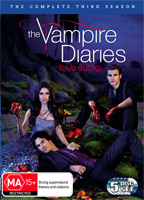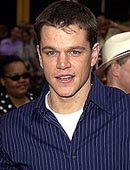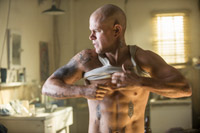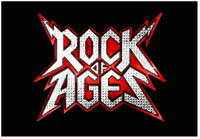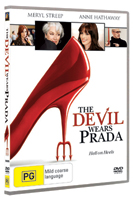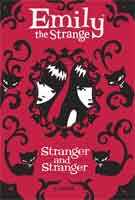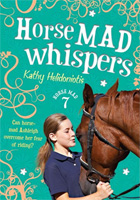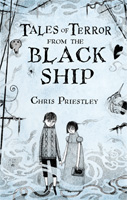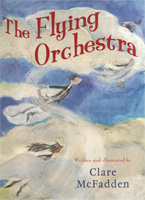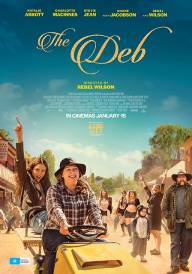Matt Damon The Great Wall
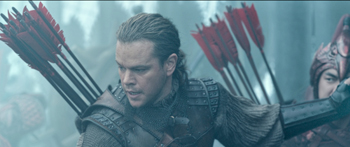
Matt Damon The Great Wall
Cast: Matt Damon, Tian Jing, Pedro Pascal
Director: Yimou Zhang
Genre: Action, Adventure, Fantasy
Rated: PG
Running Time: 103 minutes
Synopsis: Between courage and fear. Between monsters and men. A wall stands that must never fall.
Academy Award® winner Matt Damon (The Martian, The Bourne franchise) leads humanity's greatest fight for survival in The Great Wall, from Legendary and Universal Pictures. When a mercenary warrior (Damon) is imprisoned within The Great Wall, he discovers the mystery behind one of the greatest wonders of our world.
As wave after wave of marauding beasts, intent on devouring the world, besiege the massive structure, his quest for fortune turns into a journey toward heroism as he joins a huge army of elite warriors to confront this unimaginable and seemingly unstoppable force.
Directed by one of the most breathtaking visual stylists of our time, Zhang Yimou (Raise the Red Lantern, Hero, House of Flying Daggers), the action-fantasy marks his first English-language production and the largest film ever shot entirely in China. To create The Great Wall, Yimou has assembled a formidable cast and filmmaking team that represents the best of East and West in a unique global production that delivers unmissable spectacle on the grandest scale.
The Great Wall
Release Date: February 16th, 2017
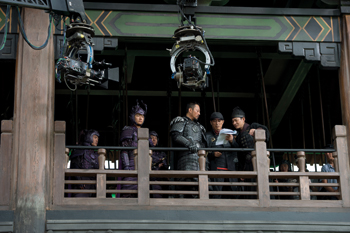 About The Production
About The Production
What Lies Beneath: Introduction to the Story
The Great Wall is set in ancient Northern China, as mercenary William Garin leads a quintet of battle-scarred warriors"on the run from warring desert factions"who hunger for wealth, power and glory. One of the group, a Frenchman named Bouchard, possesses knowledge of a new weapon, an explosive powder that could bring them all the riches they seek. This gunpowder is a fabled explosive so rare and valuable at the time that it became the -holy grail' of war, a deadly treasure some would die trying to pursue.
After barely surviving a hair-raising scrape with a desert tribe, the group is attacked one night at a remote canyon campsite by an unseen enemy. Before losing their companions in the attack, Garin and Tovar recover a strange, magnetic stone along with another trophy"a severed claw from whatever ferociously attacked the bunch. Something he's never seen before.
Now severely outnumbered, the two survivors reach The Great Wall and surrender to an unknown army of warriors called The Nameless Order, who reside inside a protected environment called the Fortress City"a bustling military outpost with incredible technologies that help protect its residents from something evil outside The Wall.
Once imprisoned, they are shackled and interrogated at a tribunal led by a trio of leaders inside the barricade. They include General Shao, revered commander of The Nameless Order (a vast army of soldiers, numbering over 100,000, divided into five regiments defined by their colorful uniforms, animal mascots and individual disciplines); Strategist Wang, the fortress' resident scientist and historian; and female warrior Lin Mae, who commands one of the five battalions"the all-female Crane Corps of fearless aerialists.
They question the pair not only about the creature's limb, but something else Garin recovered before slaying the monster. Something that intrigues the fortress' wise man and scientist, Wang"the mysterious lodestone, a magnet, that could prove beneficial in their ongoing fight against their malevolent enemy outside The Wall.
Shao, however, is fascinated by the severed claw, which belongs to a savage species called the Tao Tei, a breed of ancient, mythical beasts living deep within the Jade Mountain that rises every 60 years for eight days to feed upon humanity and punish mankind's greed.
The Tao Tei is an evolving race with a three-tiered attack force and telepathic mentality whose existence has been kept secret from the general population for centuries"merely legends and rumors to those who have never seen them or battled them face-to-face. Thus, the intrigue and wonder over Garin's battle prize, the first time these Chinese warriors have ever held the inhuman creature's claw in their own hands. Any man who could slay a Tao Tei in close quarters combat must be a great warrior indeed.
With no immediate answers for their inquisitors, Garin and Tovar realise they may never make it out of the walled city alive. While imprisoned in the fortress' barracks, they befriend a shadowy inhabitant named Ballard, a longtime captive inside The Wall, who may be their only chance for survival and freedom. Ballard shares his plan of escape from the fortress with the pair of mercenaries while also revealing a powerful new weapon developed by his captors, something the pair had traveled the world trying to find"gunpowder. Ballard's plan? Steal the Order's 'Black Powder" weapon and escape the fort, sacrificing honor for wealth.
As Ballard recruits Tovar and his plan takes shape, Garin begins questioning his own allegiances when he witnesses the sacrifice, unity and honor among the fortress' warriors after helping the Order defend its ranks from the Tao Tei during a brutal battle, proving himself a heroic fighter. As an explosive final skirmish with the creatures looms, Garin must decide: surrender to his mercenary ways and flee with Ballard and Tovar, or rise to greatness and join The Nameless Order in their ongoing onslaughts on The Great Wall…knowing his choice could mean the difference between life and death.
The Reel Wall: Development of the Film
Legendary Pictures and Universal Pictures, along with China Film Co., Ltd. and Le Vision Pictures, present The Great Wall, an epic action-adventure depicting a monstrous threat hidden for centuries behind one of the greatest manmade wonders of the world.
Set in an alternate vision of ancient China (circa 1100 A.D., during the Song Dynasty), the story imagines that The Wall was built to defend against a mythical Chinese creature called the Tao Tei (historical spelling, 'Taotie"), a malignant species and gargoyle-like figure from Chinese mythology that rises every 60 years from the heart of the Jade Mountain to attack in vast, swarming armies and feed on humankind.
'I remember being told when I was young that the magnificent Great Wall of China was the only manmade object one could see from space," says producer and Legendary CEO Thomas Tull. 'True or not, I never forgot that, and when I set out to create a company known for its monster movies, I wanted to make one that combined my love of the genre set against this magnificent structure.
'I always wondered what was so important and compelling to have a country build a structure that big, that incredible," Tull continues. 'At Legendary, we like monsters, so my geeky brain went to work on the idea of a country building this wall to keep monsters out."
As Tull developed the idea with The Great Wall's story and screenplay writers, he discussed the idea of a European soldier of fortune wandering Asia in the Middle Ages who comes upon a magnificent structure that covers the entire horizon. When the mercenary approaches, he is told that the guardians are preparing for the attack.
'During the course of developing the screenplay, Western writers actually discovered the Chinese legend of a monster called the Taotie [historical spelling]," adds producer Peter Loehr, who has spent the last 25 years of his career working in China. 'The Taotie is actually quite well known in China.
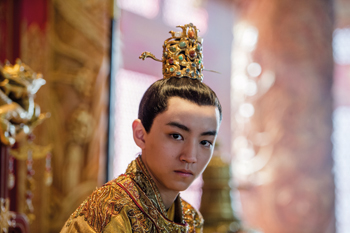 'There's a fantasy book called the -Shan-hai Jing,' which dates back 2,500 years," Loehr continues. 'In the book, they set out different types of monsters, goblins and demons, and the Tao Tei (our spelling) is one of them. The Tao Tei, in the fantastical -Shan-hai Jing,' as well as historical records, are portrayed as gluttonous. They eat incessantly, so much so that when there's nothing left to eat, they eat their own bodies."
'There's a fantasy book called the -Shan-hai Jing,' which dates back 2,500 years," Loehr continues. 'In the book, they set out different types of monsters, goblins and demons, and the Tao Tei (our spelling) is one of them. The Tao Tei, in the fantastical -Shan-hai Jing,' as well as historical records, are portrayed as gluttonous. They eat incessantly, so much so that when there's nothing left to eat, they eat their own bodies."
Producer Charles Roven, who is known for his indelible print on blockbusters from The Dark Knight trilogy (alongside Legendary), Suicide Squad and Batman v Superman: Dawn of Justice to the much-anticipated upcoming Wonder Woman and Justice League, was brought onto the production by producers Tull and Jon Jashni. He walks us through his initial involvement in the film: 'Alex Gartner and I were invited into the project by Thomas and Jon; thereafter, we were part of the original story development."
Roven reflects on his intrigue at the premise of The Great Wall: 'At the time period of our story, the Chinese were among the greatest societies…creating things the West had never seen. The gunpowder they'd invented motivates the mercenaries in our story, who are Western savages initially only out for themselves. When they come across this secret society that is trying to preserve humanity, it makes them reevaluate everything."
Producer Jashni explains that the production team long aimed to acknowledge and honor both a bygone historical period and a long-ago era of filmmaking"one in which the sets were built to scale. 'These structures were built, both then and now, to incite awe and respect," he notes. 'We knew we wanted to depict the inner workings of The Wall as practical. One might think of it as going inside a clock. It seems to do something fairly simple from the outside, but what allows it to appear so simple is rather complex. The audience might rightly assume that The Wall is merely capable of defending"by virtue of its height and its impenetrability"that which is protected behind it. We wanted to surprise them by also having The Wall be able to 'fight back' in clever and unexpected ways."
'When we began this process, Legendary wanted to make a movie that was truly an East-West collaboration," states Tull, who opened his Far East production base, Legendary East, in Beijing in 2012 and garnered success not long after with the Chinese release of Pacific Rim in 2013. 'A movie that was not just a local story, but one with global appeal as well. We found the perfect director in Zhang Yimou, one of the best in the world. What a privilege to be able to have him direct this."
In fact, Zhang Yimou is one of the planet's most celebrated filmmakers. Among his two dozen feature credits, he directed the first Chinese production to earn a Best Foreign Language Film Academy Award® nomination, Ju Dou (1990), with two more nominations for Raise the Red Lantern (1991) and Hero (2002).
Among many career triumphs, he won global accolades for his magnificent staging of the opening and closing ceremonies of the 2008 Beijing Olympiad, a feat that fan and fellow filmmaker Steven Spielberg called 'the grandest spectacle of the New Millennium from this creative genius." That accomplishment landed Zhang as runner-up for Time magazine's 2008 Person of the Year.
'When I started learning about Chinese cinema 25 years ago, Zhang Yimou's early work stood out to me," offers Loehr, who speaks fluent Mandarin. 'His early work evolved into these great martial arts epics like Hero and House of Flying Daggers. And who could forget the Olympics when you're talking about that body of work?"
As Legendary considered filmmakers for this huge production, it required the ability to straddle two cultures, to tell a very Chinese story in a way that an international audience would love. Loehr points out: 'Zhang Yimou seemed like the natural choice because he had done that in his films. He did it with the Olympics as well. Here, he took something that was inherently Chinese and made something truly amazing."
Roven agrees with his fellow producer, raving: 'The Great Wall has all the visual splendor and spectacle of an extravagant film, and it is shot amazingly by one of the most iconic filmmakers working today. His visuals are stunning, the colors that he uses are incredible, and the shots that he designs"whether they're regular 24 frames or slow-motion"are art."
The filmmaker also appreciated that Zhang Yimou embraced the throughline of cultural collaboration that permeated the story. 'Watching Yimou, with his cinematic vision, translate the script into a unique way of creating spectacle is an unforgettable memory. He was quite interested in blending the cinema styles of Western tent-poles with Chinese filmmaking," notes Roven. 'Here was material that was completely conducive to it, and we were thrilled that he wanted to join the production."
Once the director was welcomed onto the team, Roven found him to be a unique collaborator, one whose thoughtful insights and fascinating inspirations brought life to The Great Wall's story. 'Yimou contributed an enormous amount to what became the final vision of the movie," says Roven. 'A few examples are the fog battle, as well as opening the film up with the climactic sequence away from The Wall. It has been a great collaboration with Yimou and a thrilling experience working with our -East-meets-West' crew."
'The Great Wall is in the lyrics of our National Anthem, so it symbolises the same thing in the heart of all Chinese, which is our people, our country and our history," reflects Zhang Yimou. 'We use it to express many things spiritual. To all of us in China, The Great Wall is a symbol of China's national spirit. It resonates in every Chinese person, as a symbol of our traditions and our flesh-and-blood."
The filmmaker believes that applies to this story as well. 'In the movie, The Great Wall symbolizes the safeguard of peace and national spirit," he continues. 'I thought the screenplay was a special story, especially when you look at The Wall from a different angle. The Wall was built to protect our homeland from invaders. From this perspective, it makes little difference whether the enemy is people or monsters."
For Zhang Yimou, to mount this undertaking would be to celebrate enormous pride. 'This is a movie about Chinese history and culture shot entirely on location in China," he reflects. 'What attracted me most was the Chinese cultural elements. Yes, it is a monster movie, but I believed I could still express myself through it. It is a fascinating story with interesting themes and emotions."
He elaborates on producer Loehr's summary of the film's antagonists: 'For the monster Taotie, we did a great deal of research, including -Shan-hai Jing,' the classic Chinese text and compilation of ancient myths, which is China's oldest fantasy novel," states Zhang. 'They were born because of human greed. They eat massively. We Chinese still use the word and terms to this day. In traditional culture, -Taotie' is a big eater. So, it's linked with great banquets and feasts in China. Taotie has a cognitive position in Chinese culture. Taotie exist because of humanity's greed, so they are man's worst enemy. It's the greediness of humanity that produced Tao Tei, and it now recoils on humans."
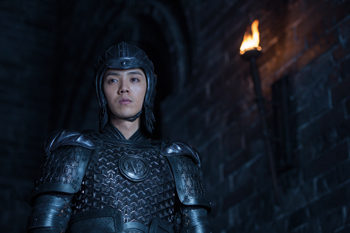 According to Chinese mythology, fear of the monster led its image to be cast often on ancient and ritual bronze vessels, daggers and weapons. Along with Taown, Hun Dun and Qiong Qi, it is one of the Four Fiends, prominent Chinese demons representing evil virtues. So intimately are the Taotie imbedded into the culture, they have even been found on Chinese currency.
According to Chinese mythology, fear of the monster led its image to be cast often on ancient and ritual bronze vessels, daggers and weapons. Along with Taown, Hun Dun and Qiong Qi, it is one of the Four Fiends, prominent Chinese demons representing evil virtues. So intimately are the Taotie imbedded into the culture, they have even been found on Chinese currency.
'To begin with, it has lots of mysteries," he continues. 'What's the story about the monsters? How did they come into being? What are their weaknesses? How many years have humans fought against them? What kinds of feelings and connections have been built among these warriors during the fight? How do they survive, or do they die in the end? There were many things to tell. It is totally different from all other monster movies."
Zhang Yimou appreciated the focus on such a cultural touchstone. 'What mattered most was the script," he says. 'The script was written by Americans, and I provided suggestions from a Chinese perspective. They welcomed and liked my ideas. It was revised and polished, trying to make it acceptable and likable to both Westerners and Chinese. That was the hardest job."
'Every genre has its limitations, and that certainly applies to monster movies," Zhang observes. 'You have to establish a set of rules. Taotie is an ancient monster that comes from our imagination. The rest of this story stands on solid ground, based on actual history. We didn't want our characters to have supernatural powers. In that case, there would be no limits. So, what we did was to set strict and basic, but very real, limitations. We placed ourselves in a realistic world, and we created an honest story. We designed everything within those limits, such as the actions, the weapons. Because The Great Wall is a very real object, a cornerstone that was built one brick at a time. We approached the layers of our story in the same way."
Manning The Wall: Characters of the Fantasy
When populating the world of The Great Wall, the filmmakers needed to find performers from across the globe to tell the epic tale. When it came to the character of the mercenary Westerner who stumbles upon this secret society, they had one name in mind. 'We needed a gifted actor who is many things at once: possesses a curious mind, is relevant to today's pop-culture and someone who is a hyper-intelligent badass," explains Jashni. 'Those qualifications immediately shrunk the list to Matt Damon, so I suggested we approach him. We knew he could authentically portray a mercenary of the period who had a lot more going on behind his eyes than simply being a formidable foe. He would communicate the complexities of being a fish out of water, allow the audience to vicariously learn from this awe-inspiring alien environment and, most importantly, evolve as a man in the doing."
Once he saw the creative leader, it wasn't difficult to get the blockbuster actor aboard. 'Zhang Yimou is one of the greatest filmmakers on the planet," raves Matt Damon. 'He paints on this spectacularly large canvas, and does it in a way like nobody else. The way he uses colors, the sweeping scale of what he does. You can look at a Zhang Yimou movie without putting his name on it, and (you) would immediately know that it's one of his. I've wanted to work with him for a long time and I finally got that chance. What a real privilege for me, for all the actors, both Chinese and Western, and the crew members as well! Everyone is here because of Zhang Yimou. We've all seen his work, and we all felt lucky to be part of one of his visions."
Matt Damon describes the story as 'historical fantasy. It's similar to the way Game of Thrones feels like it takes place in the Middle Ages. Even though we know there weren't White Walkers or dragons. Likewise, ours is not quite The Great Wall that exists today.
'We begin our story with a group of mercenaries who are being pursued by nomads in Northern China around 1100 A.D.," Matt Damon elaborates. 'It centers around this idea that The Great Wall was erected to defend Northern China from this onslaught of mythical Chinese monsters called Tao Tei that rise up every 60 years and attack with absolute ferocity. They're unlike anything we've ever seen in the west. They look like some incredible cross between a dragon, a griffin and a bear. The most fearsome things you've ever seen. And they attack in hordes to destroy anything in their path."
'In order to combat them, the Chinese have assembled this group of warriors that are raised from birth to do nothing but defend Northern China, defend The Great Wall, against these beasts," he continues. 'So, our story begins with these two mercenaries stumbling into The Great Wall. We're being chased by brigands and we get taken in, captured, by The Nameless Order on the eve of the Tao Tei's 31st rise."
'We stumble into this incredible scene of this advanced society who've invented gunpowder," Matt Damon details about the plot without revealing any spoilers. 'And, we've heard about gunpowder, so we're going to try and steal it. Suddenly, we arrive and we see this incredible army that is extraordinarily disciplined and fights in a way we've never seen. And, we get swept up in the defense of The Wall."
'One nice thing about this movie, besides being a fantasy and an adventure, is that it does deal with cultural differences and motivations of people, why they do what they do," Dafoe notes. 'You can see my character, Ballard, in this world of The Nameless Order, these very committed military people, who are trying to protect the Kingdom from the threat of the Tao Tei, this mythical monster that appears every 60 years."
'I'm very much director driven," adds Dafoe. 'As an actor, you've got to be a soldier and do your thing for the greater good. To do that, you have to have a general that you think is worth the sacrifice, because in the end, you share in making something beautiful."
Matt Damon echoes Dafoe's remarks by saying, 'it was a question mark coming in as to what extent the language barrier might be a problem. Actually, it wasn't at all. We've both made a lot of movies, so we have a shorthand and his notes were great. I got notes through a translator, but they were very specific and very clear. Giving notes is a big part of directing, and the great directors are always very simple and clear with their direction, so here it wasn't a problem coming in a different language."
Taiwanese native Frank Lin was brought in to act as the key translator between Zhang Yimou and the Western actors. Lin was a shrewd choice for the job given that he was born in Taiwan and moved to Los Angeles as a ten-year-old, meaning fluent in both his native Mandarin and adopted English. He also knew how to translate 'film speak" to the cast since he started acting as an eight-year-old in his homeland before becoming an independent director himself. To date, Lin has helmed four English-language features, all shot in L.A., with his very first winning jury and audience awards at three Pacific region film festivals.
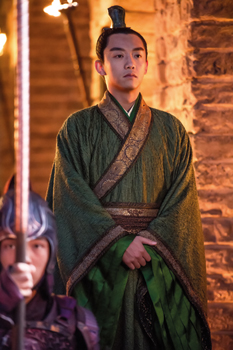 Each department on the huge production had one or more translators, many with assorted industry experience, meaning dozens on the crew for the lengthy shoot. As the film's key translator, Lin did have his challenges, none more so than interpreting and translating Zhang Yimou's unique sense-of-humor to the cast. 'He's witty, and his vocabulary in Chinese is just amazing," Lin relates. 'It was so entertaining to hear him speak and direct that sometimes I tried to match the wit, which I have to say was challenging. It's like I've never given better direction in my life, translating for Zhang Yimou. My job was to keep the language and communication flowing."
Each department on the huge production had one or more translators, many with assorted industry experience, meaning dozens on the crew for the lengthy shoot. As the film's key translator, Lin did have his challenges, none more so than interpreting and translating Zhang Yimou's unique sense-of-humor to the cast. 'He's witty, and his vocabulary in Chinese is just amazing," Lin relates. 'It was so entertaining to hear him speak and direct that sometimes I tried to match the wit, which I have to say was challenging. It's like I've never given better direction in my life, translating for Zhang Yimou. My job was to keep the language and communication flowing."
That was also the mandate when working with the Chinese cast as well, as Lin states. 'With Chinese actors, my job was to listen for their English pronunciation. One thing that Zhang Yimou wanted to stress was that the Chinese actors could have an accent, but it had to feel like they were speaking the language, not just memorizing or reciting the words. For a native speaker, it was easier to tell if it felt fake or if it was just memorisation."
'It's been over 10 years since I first worked with Zhang Yimou," says Asian superstar Andy Lau, the only cast member to have previously worked with director Zhang Yimou (House of Flying Daggers). 'Here, it goes the same, but this time, it's a Hollywood production, and Zhang Yimou did a very good job. It's hard for anybody to present the Chinese traditional culture. It's hard for us to find the balance. So he developed his own way to present the Chinese traditional culture using western framing techniques."
'He is quite open-minded and he gives us lots of freedom on set," adds Lau about collaborating with the filmmaker for a second time. 'I can't forget many years ago when Zhang Yimou told me that a movie is just like a magic picture frame. Inside the frame, anything can happen. Use your imagination, don't limit yourself."
'Visually, Zhang Yimou is on a level that few directors have reached," commends Matt Damon. 'You'll see things that you've never seen in a movie before. Incredibly beautiful shot making. Conceptually, the ways he stages the armies fighting. The way William uses his bow. What these monsters are, how they attack and what they look like"absolutely horrifying. So, it's a big, fantastical battle picture with the fate of the human race hanging in the balance. Should be really fun for audiences."
'I have loved adventure stories my whole life," Tull says. 'Here, we get the mystery of going up the Silk Road into an ancient China. Our Westerners, Matt and Pedro, encounter something beyond belief. First, these monsters, then this Chinese society working together for a common cause, to defend the Keep. The scope of the action, as seen through Zhang Yimou's lens, is truly something that we haven't seen before on film. We were blessed to have Zhang Yimou leading this amazing cast that is truly international in flavor."
Talking about his cast, director Zhang (or, Zhang dao, as he was addressed on the set in his native Mandarin) says: 'Matt is an excellent actor, a fantastic actor, and I enjoy watching his movies. His performances are persuasive and extremely natural. I will confess something"when I did The Flowers of War, I reached out to him. We even met, but unfortunately, it didn't work out. So, when I heard that Matt was on board for this one, I was really excited. My dream was fulfilled."
'It was fantastic working with him, from the very beginning to the end of the shoot," Zhang Yimou praises. 'Matt knows film, therefore, he was greatly helpful. For instance, I would ask him, -What do you think about this line?' or -What would you say here?'. I do not speak English and the lines were written by Hollywood writers, so I wanted to know what he thought. He knows the character and the story best. He always came up with brilliant suggestions."
Matt Damon describes William Garin (and sidekick Pero Tovar, played by co-star Pedro Pascal) as 'mercenaries, basically. We're the modern day version of the elite Blackwater-type guys who've been paid to come to Northern China to steal this Black Powder that we've heard about. We know that we could do very interesting things with it in the West if we could just get our hands on it."
'And, William is similar to the soldiers in The Nameless Order," he continues with the character's backstory. 'He was captured and given to an army from a very young age and was raised to know nothing but war. He doesn't really fight for a flag. He'll fight for anyone that pays him. His view of life is if you live long enough, eventually you fight for money, and that's basically what he does. He's got a very cynical view of the world, but is an extremely capable fighter, as is his best friend, Tovar. They're a two man wrecking crew. Kind of like two Delta Force guys from 1100 A.D."
Echoes Loehr: 'William and Pero have been together for quite some time; they've become brothers. They fight incredibly well together and complement each other's skills. When they combine into a single fighting unit, they're even more fearsome."
'Tovar carries two swords that he's picked up in his travels," Matt Damon explains further. 'William is an archer, a pretty miraculous archer. He and Tovar are comfortable fighting with any weapon and have been in probably a thousand different battles together. They're used to fighting side-by-side, so they're like the eyes in the back of each other's heads. He and Tovar have survived countless battles and they'll pretty much fight for anybody. In a nutshell, life has done nothing but bolster his view that they just fight for whatever side pays the most. Meaning, they're simply fighting for themselves."
'They get captured by The Nameless Order just as they start to see the defense of The Wall from these monsters," Matt Damon adds, hinting at his character's arc in the story. 'As they begin to understand what's happening and why, Tovar remains committed to our original plot, to steal the Black Powder. Whereas William, for the first time, sees that there might be something greater to fight for other than just his own personal gain. He admires, maybe in a way that he can't even articulate, the manner in which these people are willing to sacrifice themselves for each other and live for a higher ideal. That causes this real storm and eventual sea-change in William where he can no longer go around the world looking out for himself. He wants to belong to something bigger."
'From the first moment we started talking about casting, Matt was someone that Zhang Yimou wanted for the role," commends Loehr. 'As this character of William came to life, Matt was absolutely his first choice and the first person we ever went to."
Pascal was also the only actor the filmmakers sought for William's 'soul mate," as Loehr labels the character. 'Tovar's origins are Spanish, and we wanted to be true to that when casting," Loehr states about their interest in actor Pascal, a Chilean by birth raised in the U.S. who speaks fluent Spanish. 'We started to look at actors that fit that profile. At the time, we were fortunate that Game of Thrones was at the point of its season when Pedro's character was about to get crushed. We presented that to Zhang Yimou; it was a show he had also been enjoying, so he knew exactly who Pedro was and loved him for the role."
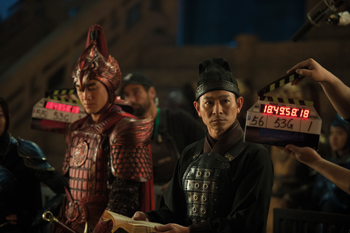 'When we contacted Pedro's representatives, we found out that he was a huge Zhang Yimou fan," Loehr continues. 'Interestingly, Pedro actually sent a long letter about how, when he was a kid, he loved to watch Zhang Yimou's movies. None of his friends were watching art films at the time, so he would walk long distances by himself to the theater. So, in the case of Pedro, we contacted one actor. We never thought about anyone else, we never went to anybody else. If you believe in fate, this certainly seemed like we were fated to work with Pedro."
'When we contacted Pedro's representatives, we found out that he was a huge Zhang Yimou fan," Loehr continues. 'Interestingly, Pedro actually sent a long letter about how, when he was a kid, he loved to watch Zhang Yimou's movies. None of his friends were watching art films at the time, so he would walk long distances by himself to the theater. So, in the case of Pedro, we contacted one actor. We never thought about anyone else, we never went to anybody else. If you believe in fate, this certainly seemed like we were fated to work with Pedro."
Zhang Yimou elaborates: 'We'd never met before. Pedro wrote me a letter saying that his father took him to a small village to watch Raise the Red Lantern when he was a boy. He grew a keen interest in Chinese films and has since watched all my works. When we first met, he said -I am here all because of you'. It is hard to imagine, and I am flattered. His performance in Game of Thrones is amazing. His acting and the chemistry between him and Matt gave the character more colors and dimensions than we could have hoped for."
Pascal describes the character of Tovar as 'a soldier of fortune, a mercenary. He's a man that will fight under any flag...if the price is right. He's a man who has lived through extreme violence and is himself a skillful warrior. A man who hails from Spain, probably born poor, recruited by the Crusades because of his incredible fighting skills, which just improve along the way."
As for his love of Yimou's movies, Pascal relates that 'I saw Raise the Red Lantern with my family at a movie theater. That got me started. From that point forward, through the '90s, I didn't miss one of his films. And, when Hero was making its way to the U.S. and his audience was expanding because of the kind of movie that it was, I was overjoyed because I was already so familiar with his other films, movies that existed on a much smaller scale. Stories that were so intimate and domestic, and very symbolic, but deeply character driven and visually sumptuous."
'Zhang Yimou is a filmmaker that I've known about for many years," echoes co-star Dafoe. 'I saw Red Sorghum or Raise the Red Lantern first and, since then, I've seen all of his films. Just great, stunning work. In the West, he's probably known more for certain films, but he's got an incredible range. He's done small films, elaborate action films, contemporary films, and fantasy films. He's even done a flat out comedy. So, I was excited to work on a big picture like this, happy to work with a good script like this with him."
'Ballard is a character who has found himself trapped in China, with this military group on The Great Wall, for 25 years," the actor offers. 'He arrived there years before with a caravan, ostensibly to do business. Things didn't work out, and he got stranded there. Because he's a clever guy, he found a way to survive among this military culture that's protecting the Middle Kingdom."
'To survive, he made himself useful by teaching them English, by sharing any knowledge he had about military strategies of the West," Dafoe elaborates. 'He works with them to earn his keep. And his keep is pretty modest because they keep him only because he's useful to them. The quintessential expat, he's an educated man, a man that was in high circles who can't quite believe his bad luck. But, he does have a plan, a design, to get back to the West. He's discovered that the Chinese have made gunpowder. He's got a great imagination about what that would mean to his own fame and fortune if he could bring that to the West. An imagination of another life that he could have."
Director Zhang Yimou called Dafoe 'the ideal actor to play Ballard. No need to say more. I've seen so many of his films, such as Platoon. He is extremely dedicated and professional. He always was the first one on set, doing rehearsals. He is meticulous in every line and detail."
'It was a pleasure working with all three of these Hollywood talents," hails director Zhang Yimou. 'They showed a high level of professional ethics and responsibility. The three actors were respected not only by me, but our entire Chinese crew, who all praised them highly. We have not worked so closely with top Hollywood talent before, and they impressed everyone. I believe this has set a promising start for Hollywood actors working in China."
For The Great Wall, Zhang Yimou manned his production with some of his homeland's best known actors, two of whom played key characters who are required to speak both Mandarin and English. 'One of the big challenges was that this is a Chinese-themed picture with Western characters sprinkled throughout in an organic way," Loehr explains. 'At the same time, it's an English-language movie. Some of the Chinese characters had to speak fluent English, and that thinned the ranks for a lot of the local actors. Specifically for Strategist Wang and Lin Mae, who both have to speak fluent English in the film."
Loehr relates that the filmmakers put together a list of five candidates for each of the dozen main Chinese characters in the story (most of whom speak only in Mandarin, with their dialogue subtitled). Once they had their list, the filmmakers began meeting each person one by one. In some cases, they met all five candidates for a role. For other roles, they considered only one person.
'In the role of Lin Mae, Jing Tian was on our original list," he continues. 'She auditioned early on, when her English was not that good. She was ambitious enough to have already hired a teacher who was spending 12 hours a day with her, unbeknownst to us, working on her speech."
Adds director Zhang Yimou, 'Though Jing Tian is a young actress, she knew there was a lot to bear as a major character. Her intensive training in America, especially language, all reached my standards. She was very hardworking from the beginning."
Jing completed several months of intensive English language instruction and assorted training (stunts and horseback riding, in particular) so she could meet the physical demands of the role. As well, her background in dance (she studied the art at the Beijing Dance Academy) would serve her well for the film's vigorous action sequences.
'Tian went to the States and worked her butt off," Loehr enthuses. 'She was getting -A' marks on all fronts, both training and English. The dialect coaches (Hollywood veterans Judi Dickerson and Francie Brown) were really happy with her by December, and that's when we pulled the trigger. She spent another three months in the U.S., and not only won the role, but won everybody over. She's an up-and-coming star, but she went out and got it on her own, and we give her kudos for her accomplishments."
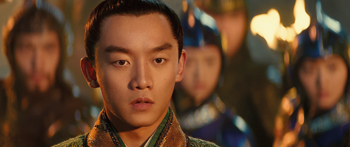 The 28-year-old actress may have been destined for such a role, given her coincidental connection to Zhang Yimou's birthplace. She grew up in the walled city of Xi'an in the Shanxi Province (a five-hour train ride from Beijing). She also is an alumnus of the Beijing Film Academy, from which Zhang Yimou also graduated (in 1982) as part of the first group to earn their degree following the end of the turbulent Cultural Revolution of the 1960s and '70s.
The 28-year-old actress may have been destined for such a role, given her coincidental connection to Zhang Yimou's birthplace. She grew up in the walled city of Xi'an in the Shanxi Province (a five-hour train ride from Beijing). She also is an alumnus of the Beijing Film Academy, from which Zhang Yimou also graduated (in 1982) as part of the first group to earn their degree following the end of the turbulent Cultural Revolution of the 1960s and '70s.
Their hometown of Xi'an is a city with 7,000 years of history where the vast armies of Terracotta Warriors date from the Qin dynasty circa 256-210 B.C. (the city houses the only national museum celebrating Emperor Qin's army). With such a pedigree, it seemed almost fateful that Jing would become involved in a feature film (her first Hollywood and English-language project) that showcases, in a fictional way, a vast army of Chinese warriors fighting on her homeland's grand monument to save mankind.
'I felt so honored to work with Zhang Yimou," Jing states. 'As we all know, he is one of the best directors in the world. In giving me this opportunity, he had great confidence in me. Every day on the set was like taking acting classes. Like many in our cast, he is a director I wanted to work with for so long, so it's like a dream come true. He is the pride of the Chinese film industry."
'Lin Mae is a general who leads the Chinese Army," she states about her character. 'She is a woman of many virtues. She is strong, brave, reliable, determined and daring. She has all the talent and wisdom needed to lead The Nameless Order. As a female general, she is the -girl power' in a film dominated by male characters. Lin Mae was born into The Nameless Order, a secret organisation that no one knows about, except for the Emperor. When she was very young, General Shao saw her potential. He told her everything he knew, and then trained her to become a strong, capable commander. He passes his command to Lin Mae, who feels the responsibility to carry on General Shao's legacy. Also, Lin Mae and William have a lot of action scenes together."
Matt Damon jokes that one might call the film 'The Women and The Wall. Lin Mae eventually becomes the General in charge of the entire army. She's an extremely powerful person. He changes completely based on his time in the Fortress City, and a lot of that happens through the character of Lin Mae."
If the character of Lin Mae is one of the story's bravest, as Matt Damonsuggests, he complements his remarks by adding that 'Strategist Wang, played by Andy Lau, is the smartest guy in the movie. He's got these incredible inventions and is the brains behind The Nameless Order. He's somebody that William cottons to, and has a great deal of respect for."
That respect was also evident between the two actors who had never met before the five-month shoot, but who had a professional connection in their prior work. Turns out that they played the same character in two different movies"Lau as the corrupt police inspector in the 2002 Hong Kong crime thriller Infernal Affairs, and Matt Damon as the devious undercover cop in The Departed, the 2006 English-language adaptation. It was something the actors joked about during some of their casual chats on the set during breaks in filming.
'I told Matt that he was cleverer than me because he got paid more for his movie," the veteran of more than 150 films jests. 'Matt told me that I'm cleverer than he is because he dies in that, and I lived to do two sequel movies. I enjoyed working with Matt and feel he has become a good friend. I'm looking forward to working with him again."
Lau got the chance to work with Zhang again in the role of Strategist Wang, a character he describes as 'a scientist spending his life doing the research about the enemy and trying to fight against them. During the Song Dynasty, the society was quite open, so lots of Chinese culture was well developed and many great thinkers and inventions were founded. That's why I think they (chose) Song Dynasty as the background for this movie."
The Great Wall is set in 12th century China, which was an interesting period because there was a renaissance in China at that time, with art and science. Notes production designer John Myhre: 'Our film uses a lot of the scientific developments that were created at that time. Strategist Wang is an amalgamation of famous scientists of the time."
'The Hall of Knowledge set was like a science lab for me, to develop my crazy ideas and inventions and weapons to fight against the Tao Tei," Lau continues, referring to Myhre's visually stunning set piece housed inside stage 8 at CFG Studios. 'It was like a library to keep all our ancestors' experiences."
As for the challenge of the bilingual role, Lau confesses that 'it's really hard for me to practice speaking English. I got the script a month before shooting and it took me two weeks to fully understand the story. Then it took me another two weeks to remember all the lines. Luckily, we had dialogue coaches on set, who coached me in a very good way. I also have to say thank you to Matt and Willem because they gave me very good suggestions while I was performing. Willem was like a teacher of mine, trying to polish my performing to make me feel great in front of camera. Matt was also a team player, always considerate to everyone's place on the set."
'Andy Lau is one of the best actors in China," Zhang hails. 'He has been popular in China for 40 years. There was a lot of English dialogue for him, even more than the foreign actors. Though he speaks English well, he wanted to tell the world Chinese actors speak English well, and he practiced hard."
As for the challenge of casting the remaining key roles in the production, Loehr says 'it was quite an interesting process because our Chinese cast is a huge all-star cast. We told each of them the approximate shooting schedule. We were not ready to give them a script at the time because we were still working on it. For these other Chinese stars, we needed them to sign on unconditionally. They all had to take a leap of faith. Fortunately for us, they all signed on with those dictates. The day of the cast announcement was the first day they knew who else was in the movie."
Apart from Andy Lau, Zhang Yimou was working for the first time with the other key Chinese cast members, all stars their native Asian markets, with seven (of the 10 other main cast) playing soldiers in The Nameless Order.
'I've always wanted to work with director Zhang," says Chinese actor Hanyu Zhang [no relation], a Beijing native who plays General Shao, the commander over all five of The Nameless Order regiments. 'He was the reason why I took this role, and I feel honored to be in his film. I like his early works such as To Live, and, the 2008 Olympics Opening Ceremony was spectacular. He's portrayed different themes and styles all throughout his career."
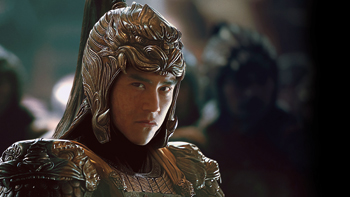 Like Hanyu Zhang, other key Chinese cast playing members of The Nameless Order discovered their roles in the March 2015 casting announcement. They included Eddie Peng Yu-Yen as Commander Wu, the head of the army's Tiger Corps, the brigade adorned in gold armor (the Taiwan native was the only other Chinese cast member fluent in English, having spent his teen years in Vancouver, although he does not speak the language in the film); Lin Gengxin as Commander Chen, the leader of the Eagle Corps, the crossbow marksmen dressed in vibrant red uniforms; Xuan Huang, a local art-house star, as Deng, who commands the purple-armored cavalrymen, the Deer Corps; a pair of young Chinese actresses, Yu Xintian and Liu Qiong, who wear royal blue armor as lieutenants in Lin Mae's Crane Corps; and Asian pop sensation Lu Han as one of Gen. Shao's young Bear Corps cadets, the combat solders dressed in black.
Like Hanyu Zhang, other key Chinese cast playing members of The Nameless Order discovered their roles in the March 2015 casting announcement. They included Eddie Peng Yu-Yen as Commander Wu, the head of the army's Tiger Corps, the brigade adorned in gold armor (the Taiwan native was the only other Chinese cast member fluent in English, having spent his teen years in Vancouver, although he does not speak the language in the film); Lin Gengxin as Commander Chen, the leader of the Eagle Corps, the crossbow marksmen dressed in vibrant red uniforms; Xuan Huang, a local art-house star, as Deng, who commands the purple-armored cavalrymen, the Deer Corps; a pair of young Chinese actresses, Yu Xintian and Liu Qiong, who wear royal blue armor as lieutenants in Lin Mae's Crane Corps; and Asian pop sensation Lu Han as one of Gen. Shao's young Bear Corps cadets, the combat solders dressed in black.
As an Eagle warrior later in the story, Matt Damon dons the regiment's signature red armor for scenes alongside Chinese co-star Lin Gengxin as the Eagle commander. Another was Lu Han, one of China's biggest pop music stars, who made his acting debut in the film as the Bear Corps cadet, the cowardly Peng Yong.
The Beijing native burst onto the Chinese music scene in late 2011 and his popularity on the music charts led to an explosive following on social media in China, which national economists have dubbed the 'Lu Han Effect." He is constantly followed on Sina Weibo (China's version of Twitter), and across social media, where his followers are astronomical in number.
Matt Damon had not heard of Lu Han, but soon realized the performer's idol status. 'Before his first night of shooting, Lu Han had 400 flower arrangements sent by fans. They filled the entire hotel hallway. Apparently, when he travels to location, fans will buy up all of the tickets on the plane or the train he's riding. It was a little overwhelming. But, if I hadn't been told Lu Han is as huge a star as he is, I wouldn't know by the way he carries himself. He's so down-to-earth."
In casting the likes of Lu Han and another Chinese pop music phenomenon, Junkai Wang"frontman for the Chinese boy band TFBOYS"in crucial roles in the film, director Zhang says that 'all these young idols were strictly selected. Lu Han and Junkai Wang are young and very popular. They are called man gods here, but they fit the characters in every aspect"age, looks and characteristics."
Speaking of co-star Junkai Wang, who had never before acted professionally and dramatically (he was just 15 years old when he shot the film), Zhang Yimou admits that he approached his relationship with the teen idol, who plays the fortress' Emperor, as more of a patriarch than filmmaker. 'We had given him some strict tests before casting him. We had acting lessons for him as well. He proved his talent, fit the role perfectly, and I dare say he should consider attending the Beijing Film Academy. He is that talented."
The Nameless Order: Five Key Corps
Early during the process of developing the screenplay, the filmmakers referred to The Nameless Order as 'Men in Black in the Song Dynasty." Laughs Loehr: 'That was our one-line pitch. It became much more than that over the various iterations of the screenplay. The Nameless Order is a very large force, hundreds of thousands of soldiers, who are split up into different divisions that have specific functions and different commanders for each of these five troops. The Nameless Order is the ultimate fighting force that dedicates their lives to protecting this world behind The Wall. This last bastion of opposition to this indestructible force, the Tao Tei."
In essence, these five key corps each have a special function because The Wall, as it's realized in the movie, is not The Great Wall everybody thinks it is." Loehr reflects: 'We think of it as an aircraft carrier or a giant Swiss army knife, with all kinds of things built into it that are designed for battle. Feasible in the period, but specially designed to fight off the giant threat from the Tao Tei."
Loehr details each of these five regiments: 'The Eagle Corps are dressed in red and are archers, working both a classic, hand-held crossbow, but also a special super-sized repeating crossbow that shoots bolts at a high speed over a long distance. They're a -mid-range troop' that fights the monsters."
The Tiger Corps is the Corps of Engineers." On Loehr: 'They are dressed in gold and design and work the machinery and artillery that require strength and engineering genius…like the trebuchets that are our long-range weapon shooting fireballs over very long distances from behind The Wall. They generate all the power to operate these weapons. If our wall was an aircraft carrier, they would be the guys down below, manning the engines."
'The next group, key at the beginning of the movie, is the Bear Corps, close quarter fighters which, in the case of the monsters we portray, is a suicide force," Loehr explains. 'They are the fiercest, but also their attrition rate is the highest. When the monsters get past the blades and other lines of defense to breach the top of The Wall, these guys who wield axes as they're slaughtered by the monsters, are the last line of defense. General Shao, who is the commander of the entire Nameless Order, is also the Bear General.
'Then we have the Deer Corps, our cavalry and infantry force," he continues. 'They are the last line of defense once The Wall has been breached. Fighting in formations with shields trying to keep the Tao Tei from getting to the other side. They oversee a series of nets that trap the monsters. If the Tao Tei get caught in the nets, these soldiers rush to kill the monster before it frees itself."
'One of the more interesting corps, the final one, are the Cranes, dressed in blue," he details about the last of the five regiments. 'The reason they're dressed in blue is that it acts as a camouflage for them, because they're coming out of the sky, so-to-speak. They work off of what we called a flying rig, which was something that we designed especially for the movie."
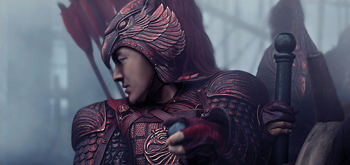 'They were tethered to the rig through a special flying ring that allowed them to leap down and back up without using a bungee," Loehr describes. 'They dive like birds with long spears after their prey, stabbing the monsters before they bounce back up to their initial position on top of The Wall."
'They were tethered to the rig through a special flying ring that allowed them to leap down and back up without using a bungee," Loehr describes. 'They dive like birds with long spears after their prey, stabbing the monsters before they bounce back up to their initial position on top of The Wall."
Shares director Zhang: 'For the army, things like armor designs, colors and the corps themselves, they all originated from traditional Chinese culture. In our history, Chinese often used different colors to represent different armies."
William and Tovar encounter this group of soldiers with extraordinary discipline, separated into different groups by the colors they wear, and the specific jobs they execute. Matt Damon states: 'They train their entire lives to defend The Wall, and work together seamlessly. From a military standpoint, William and Tovar are extremely impressed with how skilled and disciplined they are."
As the story progresses, William earns the right to wear the red Eagle armor because he proves himself as an archer. 'During the course of the film, William is confronted with this army that challenges his whole life view as he witnesses, through a series of battles alongside them, how they sacrifice themselves for one another on The Wall," Matt Damon elaborates. 'That they're all living for something that is greater than any of them is something he's never encountered before. He starts to come to grips with the fact that there is something bigger than just himself and his own life."
An Enormous Shoot: Logistical Summary
Filming began on March 30, 2015, at Beijing's state-sanctioned China Film Group (CFG) Studios, where Myhre's artistry included such sumptuous stage sets as The Great Hall, which houses the fortress' tribunals; Strategist Wang's Hall of Knowledge, harboring not only the alchemist's scientific experiments, but also the extensive history of The Wall and fortress; and the lavishly adorned, red-and-gold Imperial Palace, the outpost's crown jewel where The Emperor holds court, to name but three among almost three dozen sets he designed.
Producer Roven reflects that one of his fondest memories of the production was observing how deeply committed the East and West teams were toward ensuring the production remained a seamless collaboration. He commends: 'I was impressed with how dedicated both crews were, even though their methodologies of making movies were culturally diverse. Both worked at making the film's themes work practically, in that they grew to believe that both sides could benefit from working together and learning from each other."
In addition to the company's 10-week shoot at CFG Studios, the production also spent an equal amount of time on location in three remote locations. The first was the seaside village of Huangdao, the site of a planned major film studio by China's Wanda Group (now controlling partners in Legendary) on the shores of the Yellow Sea. There, Myhre's crew erected several pieces of The Great Wall, including a 500-foot replica of the ancient structure where Zhang staged numerous battle sequences over a six-week period before returning to CFG Studios in Beijing for the month of June.
In July, the company moved to Dunhuang, just outside the Gobi Desert in the Gansu Province, where Zhang mounted early scenes of the story in the remote, foreboding and scorching (110 F temps) Yadan Geopark, a location in which he first worked on Hero. The company next traveled to Zhangye's Danxia Geological Park, home of China's spectacular Painted Mountains, a place he had previously filmed for A Woman, a Gun and a Noodle Shop, the first movie to shoot in one of the planet's most unique natural landscapes. Following three weeks of location work in these two sites about 1,200 miles northwest of Beijing, the production returned to China's capital city in late July, and concluded filming at CFG on August 7, 2015.
Building The Great Wall: The Massive Production
While the film's cast did have to imagine the presence of the movie's monster, the Tao Tei, in a green-screen environment, there was nothing make believe about production designer John Myhre's magnificent set builds during the five-month shoot in China, both on studio sound stages and the Huangdao location. The two-time Oscar®-winner's designs were so spectacular, the cast was in disbelief at his incredible accomplishments.
The filmmakers knew they were up to a mighty task to put a Great Wall on screen that could make the audiences feel as if they were atop, inside and around this monolithic structure. 'Ambitious movies are often rooted in the idea that things are not always as they might appear," reflects Jashni. 'The Wall is a literal and figurative barrier to be crossed"but that crossing can only be achieved with great strategy and great respect. We'd like to feel as if The Wall, which feels almost a co-star in our movie, is a metaphor for East-West cultural exchange. Bravery and courage are required to pass its boundary, and there is absolutely more to this Wall than meets the eye."
'The scale of this movie was stunning," says Loehr. 'Our Great Wall set was a square kilometer, harking back to the Golden Era of epics in the 1950s and '60s, when massive set builds were the norm. They certainly don't get made this way in China. This is the largest movie shot in China so far."
'John killed it on every set that he built, all of them just unbelievable," Matt Damon praises. 'I hope that the crafts people involved are up for technical awards, because there are a number of departments that did incredible work. It boggles the imagination what WETA did with the weapons, what Mayes did with her amazing costumes, and what John was able to do with his production design."
Myhre has stood on Oscar® podium twice to accept the industry's highest honor for his art direction on a pair of Rob Marshall films"Chicago and Memoirs of a Geisha. With three additional Academy Award® nominations, the modest artist, while proud of those achievements, counts the phone call he received about meeting Zhang Yimou as one of the highlights of his career.
'It was one of the best calls I ever got in my life, because I've always been a fan of his work," Myhre enthuses about that 2014 moment. 'I never dreamed I'd get a chance to work with him. Even if I did not get the job, what an honor to meet director Zhang and be considered for the job. He's always been one of my cinema heroes because of his visual mastery."
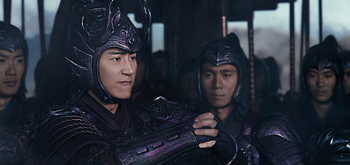 'Creatively, John and Zhang Yimou were a good match," says the film's Oscar®-winning Chicago set decorator Gordon Sim, Myhre's longtime collaborator. 'Even though they did not speak the same language, they understood each other's vision and what each brought to the film."
'Creatively, John and Zhang Yimou were a good match," says the film's Oscar®-winning Chicago set decorator Gordon Sim, Myhre's longtime collaborator. 'Even though they did not speak the same language, they understood each other's vision and what each brought to the film."
'I came prepared for the interview with a visual presentation of what I would do if I was hired on the project," Myhre recalls. A couple of weeks later, I was sent two huge boxes of historical research from his team"books and images of paintings of the time."
Adds director Zhang: 'I was very satisfied with all John's designs. He is a genius with brilliant ideas. He did a lot of research. His spectacular designs impressed us all."
The Great Wall is a big, epic movie, and our title character is, obviously, very important to the movie," Myhre notes. 'Director Zhang wanted to be very true to The Great Wall. We did a lot of research. I worked with him on all aspects of the design to be very true to China of the period. It was something he felt very passionate about, as did I."
'We found that there aren't any surviving segments of The Wall from the 12th century," Myhre states, referring to the story's setting during the Song Dynasty of the era. 'So, we had a little latitude. We went to many different parts of The Wall built over the years, took photographs and images of little details. Right away, we wanted to use more gray stone than the brown or red stones that make up the actual Wall. We made that choice because the colors of The Nameless Order, the purples, the blues, the golds, the reds that they wear, would stand out so beautifully against black and white as opposed to brown and white."
'My team in China looked at me like I came from another planet when I described how I would build the wall in Los Angeles [with prefabricated sheets of brick]," he admits. 'So, I asked them how they would build The Wall. They said out of stone and brick and fill the inside with dirt. And I said, -like the real Great Wall?' So, our Great Wall is built as The Great Wall would have been built in the 12th century. We used 200,000 bricks on our exterior Great Wall sets!"
'We made it a little wider than it would normally have been because we had a lot of horses on The Wall for different bits of action," he continues. 'And, the most important thing was we hollowed The Wall out. Very much like an aircraft carrier, our Wall had several levels, each with different weaponry that is used throughout the movie. All the weapons are hidden within The Wall."
'All of the weaponry on The Wall was designed for each of the animal corps, and each of the weapons had characteristics of those animals, much like their costumes do," Myhre explains about the assorted set pieces he constructed onstage to represent different portions of The Wall inside the fortress. 'So, the Eagles' nests have eagles on them. The flying rigs, which are for the Crane warriors, have a beautiful crane on the top. When it opens up like a fan, the fan is almost like feathers."
'When The Wall goes into battle mode, stone trapdoors open up and flying rigs come out for the Cranes, Eagles' nests for the archers, trebuchets come out. So exciting," Myhre enthuses. 'We based it on things that could have been real in the 12th century. Taking on this idea that in this era, the Chinese had actually harnessed water power, using that as a source of power for these weapons."
For the exterior Wall sets, Myhre and his team built four sections on a plot of land adjacent to the Yellow Sea in the village of Huangdao, about 500 miles from Beijing (the location was a 45 minute drive to Qingdao, a city of 9 million people known as the home of the famous Chinese brewery, Tsingdao).
The largest section stretched almost 500 feet, curving through a 'canyon" of exactly 293 shipping containers (40 ft. long, 8 ft. wide and 8.6 ft. high) assembled five high, soaring over forty feet above the set like giant Lego building blocks. The rigging grip crew, led by movie veteran Oscar Gomez, hung huge green screen fabric over the containers, creating a backdrop for visual effects to extend Myhre's Great Wall set across the horizon and into the distance. Matt Damon called this emerald fishbowl, if you will, 'one of the biggest exterior green screen environments ever mounted for a motion picture."
Myhre, working with veteran supervising art director Helen Jarvis, designed more than six dozen sets on paper for the project, with 28 ultimately coming to fruition under the collective craftsmanship of 'six, seven hundred people within the art department in terms of carpenters, painters, plasterers, set decorators and prop builders," he confirms.
In addition to the four exterior portions of China's grand monument, Myhre's major set builds for the production also encompassed designs that represented interior sections of The Great Wall and the story's Fortress City. Those included the fortress' Great Hall, Strategist Wang's Hall of Knowledge, the Emperor's Imperial Palace, Ballard's cavelike 'suite," the Imperial Palace's pagoda and the 'inner" wall, the latter a massive four-story structure which contains the machinery (turbines, water wheels) that powers the ancient weaponry devised to battle the Tao Tei.
'The design of the inner wall came together quickly in a conversation with director Zhang very early on," Myhre relates about the behemoth build on stage 12 at CFG Studios. 'He wanted it to be a series of different floors, powered with water. After sketching it out, we built the first floor with giant turbines that power all of The Wall's mechanisms. We had a waterfall above the fortress that took water into The Wall, giant water wheels that moved all the gears and cogs. Up on the next level were carts that sent blades outside the walls to cut off the Tao Tei's heads once the attack begins. On the next level, we had the trebuchets"catapults that shoot giant fireballs. Hundreds of trebuchets launching hundreds of giant fireballs to create this wall of fire that stops the Tao Tei for a moment. On the very top floor, we had the Eagles' nests manned with giant crossbows."
The inner wall set was one of the last on which the company filmed, almost three months after production commenced at CFG Studios on March 30, 2015. The filmmakers began their four-plus month shoot on a set called The Great Hall. Myhre called this majestic set, which consumed the entire circumference of stage 11, 'a multipurpose room in the story. At some points, it was used as a place where people would eat. At other times, it was used as a place where people were being debriefed. This big gathering hall is where a tribunal meets to question William and Tovar."
'More often than not, there were 500 people in the Great Hall," Myhre relates about the three-story set, on which production filmed for the first two weeks of its schedule, populating it with hundreds of Chinese extras. 'In addition to the balcony and the floor, I had this idea of doing a bit of stepped seating, which was inspired by going to China's Forbidden City in Beijing and seeing people sitting on its steps, their heads one above the other. That layout allows the viewer to see all these people, adorned in these beautiful costumes and weapons. While it wasn't traditionally or purely Chinese, it was a design that director Zhang liked and approved."
The build also allowed Myhre to incorporate loads of key imagery into the set, notably the monsters. 'In the 12th century, there were Tao Tei patterns and designs on a lot of real objects of the era," he says. 'We extrapolated that imagery and put it into moldings and pillars around the base of the steps. In fact, the centerpiece of this set was a giant hand carved wooden Tao Tei."
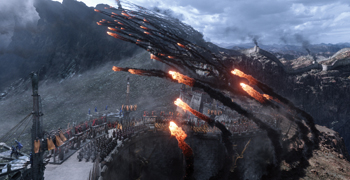 Another captivating set designed for the film was the Emperor's throne room inside the Imperial Palace. 'This being the Song Dynasty of 12th-century China, all the details were very specific to that era," Myhre states. 'Our wonderful Chinese art director, WANG KUO, brought forth all the inspiration for this set. I designed the movie, but Wang Kuo deserves the credit for this set. I can say it accurately represented Song Dynasty architecture. What might be a little different was the dragon carving behind the throne. Very theatrical and incredibly beautiful."
Another captivating set designed for the film was the Emperor's throne room inside the Imperial Palace. 'This being the Song Dynasty of 12th-century China, all the details were very specific to that era," Myhre states. 'Our wonderful Chinese art director, WANG KUO, brought forth all the inspiration for this set. I designed the movie, but Wang Kuo deserves the credit for this set. I can say it accurately represented Song Dynasty architecture. What might be a little different was the dragon carving behind the throne. Very theatrical and incredibly beautiful."
Another design in which Wang Kuo was instrumental was the Imperial Palace pagoda, which stood on stage 13 at CFG Studios and played in the film's climactic third act. 'The pagoda set had the most extreme use of color light that any of us have ever done before," Myhre observes. 'The pagoda was surrounded by colored glass windows with colored light streaming through to illuminate the set completely. Director Zhang had the vision of the colored glass. So, we started researching colored glass of the era. We think of stained glass windows as individual green and red and blue pieces put together with metal leading. In early China, they created pieces of glass where color flowed together. It turned out beautiful."
Myhre's design for Strategist Wang's Hall of Knowledge, which stood inside the studio's stage 8, may have been the most spellbinding set of the 28 erected. It is the backdrop for the character's monologue to Garin and Tovar about China's vast history, a speech that actor Lau expertly delivered in his third language, English, a moment Matt Damon deeply admired.
Myhre describes his design for the exquisite yet mysterious chamber by saying, 'Strategist Wang plays a major role in the movie. A brilliant mind, a scientist and inventor, he's the one who's created all of these amazing weapons. In doing research, we found in the late 11th, early 12th century, that there was this amazing observatory built in China, which is in the shape of a pyramid. The top is flat and it's where all of the equipment was to observe the stars. We felt Wang would have built that planetarium."
'The interior of the set was another bit of fantasy," he offers. 'I love the idea that it was inside of a pyramid, so I wanted to emphasize the shape of the pyramid. Instead of putting in straight bookcases, all the bookcases are stacked and angled, a story-and-a-half high, to emphasize the shape of the room. And, there are a number of inventions we created for the movie, mixed in with real scientific achievements of China from that period."
'The set serves as a scientific lab for all of Strategist Wang's experiments," Myhre continues. 'If you look carefully, it's a tipping of the hat to all of the great inventions of 12th century China. You'll see the world's first seismograph, first compass, early printing presses. You'll see a model of a water clock that for 300 years was the most accurate water clock in the world." 'We also filled this inner sanctum with all the knowledge of our world," Myhre explains. 'Wang has been cataloguing every event that's happened in China for thousands of years, which we depicted on scrolls. So, it's a research library. The idea of Strategist Wang's scrolls was based on the notion of shooting through something transparent. I love shooting though fabric, as does Zhang. So, Gordon, along with Mr. Yanmin Sun, our Chinese set decorator, worked for months with director Zhang to get the scrolls to tell exactly the story that he wanted to show. There are 13 beautiful silk scrolls that visually tell the story, both of ancient China and the movie's story."
Besides being a scientist and observer and inventor, Strategist Wang is also a record keeper and historian. During his lifetime, he's been in charge of keeping all the information about what they know about the (Tao Tei), which is stored in this sort of vault. The hall has a vault-like feeling and a tomblike feeling. Wang tells the progression of the Tao Tei, how they came into existence, and how The Nameless Order fought them."
Arming an Empire: Props, Weaponry and Training
The Hall of Knowledge mandated another huge prop build from Sim and his crew. To embellish Myhre's set, Sim's team manufactured, all by hand, the 13 embroidered scrolls hanging from the ceiling, almost 3,000 Song Dynasty books, 35 black lacquered tables and chairs and 20 maps.
'We set up a department of local prop makers that made everything for real. For instance, if you're going to build a carriage, they started by forging the axles and creating wheels with wheel smiths. Pottery was made as you would make real pottery. The Chinese team had wood carvers, metalworkers, sculptors, plasterers, all incredible. We passed the 20,000 mark in the number of props manufactured. That encompassed swords, knives, spears, bowls, goblets, furniture."
'We had to build every single item on this film, down to cutlery, spoons," Sim confirms. 'I think the only thing we didn't build was chopsticks. But, everything else was built from scratch, handmade, sculpted, molded, built by wonderful carpenters. Everyone on the crew was blown away by the quality of the set dressing pieces, the scientific equipment. The scale of set decoration on this film was monstrous. We made over 1,000 pieces of pottery for the dining sequence in the Great Hall alone."
Those staggering numbers also translated into the hand props and weapons designed, says the production's Western propmaster, Montreal-based movie veteran LECLERC, who reunited with Myhre and Sim for the film. 'This was like making the original Ben Hur; we had to create everything. We were lucky to have worked with the extraordinary expertise of WETA Workshop. I do believe that this movie was bigger than The Hobbit in the number of weapons made. The Chinese prop-making crew, numbering in the hundreds, was absolutely amazing in their art, skill, sculpting, molding, illustrating."
WETA Workshop's Richard Taylor confirms that figure. The British native, based in Wellington, New Zealand, collaborated with Peter Jackson on The Hobbit and The Lord of the Rings franchises, for which he and his team collected four Academy Awards® for ingenious designs for makeup, wardrobe and visual effects in handcrafting Tolkien's richly detailed cinematic worlds.
For The Great Wall, Taylor began working on preliminary weapons designs more than two years before production began in early 2015. He states: 'The weaponry for the 12th century period of the Crusades needed to feel real so that the film didn't go into a level of heightened fantasy. However, our designs also had to have a creative edge of the fantastical."
While Taylor and his WETA designers have been manufacturing prop weapons in China for almost two decades, the film represented his very first design for a Chinese-themed story, to which he says, 'it was critical that we put in a depth of research, that we really began to look under the surface of this piece of mythology."
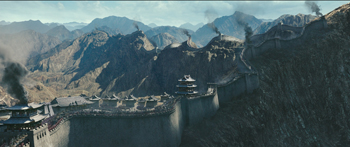 'We were able to access a great deal of literature on this period in Chinese history," he confirms. 'There's an immense depth of research done by Chinese historians on the weaponry of this period. It's incredibly well-documented, and we were able to draw on all of that."
'We were able to access a great deal of literature on this period in Chinese history," he confirms. 'There's an immense depth of research done by Chinese historians on the weaponry of this period. It's incredibly well-documented, and we were able to draw on all of that."
'I would imagine that if you were an academic of Chinese history, any period is incredible, whatever the dynasty in power," he continues. 'But, at this time, there was such invention and such extraordinary advances in the technologies that would take another 500 years to reach the Western world. And those technologies have informed so much of what China is today. Studying this period of history, we came to understand how the Chinese people were able to utilize all of their knowledge and experimentation in astronomy, alchemy, chemistry, metallurgy, and how that informed the quality of weapons manufactured at this time in China, which was very advanced."
WETA's on-set weapons/armor supervisor was one of the company's longtime associates, Joe Dunckley, a New Zealand native who served in a similar capacity on several other WETA-designed projects like The Lord of the Rings and The Chronicles of Narnia trilogies, among other titles.
Dunckley oversaw a location team of three dozen who handled an arsenal of over 5,000 prop weapons (reportedly, more that WETA manufactured for either of Peter Jackson's Tolkien trilogies). Their cache (manufactured by a team of 250 builders at WETA's Wellington, NZ factory) included swords, daggers, scabbards, crossbows, longbows, arrows, quivers, sheaths, shields, spears and axes, all designed to match the signature uniform colors and disciplines of the five aforementioned armies that make up The Nameless Order.
Each of The Nameless Order's corps carried a handsome shield, 70cm (2.3 feet) in diameter, made from a granular-activated carbon manufactured from specially selected grades of steam-activated coal. The shield, which weighed about 8-10 lbs., was painted in the color of each army and was embossed with the emblem of the animal for which each corps was named (i.e., a red Eagle; blue Crane; gold Tiger; silver Bear; purple Deer).
Many of the 500 extras who worked virtually every day on the shoot (playing members of the five Nameless Order armies) also carried spears whose heads were designed to symbolically illustrate the specific discipline and identity of each corps.
'For instance, the Eagles had four meter lances with a large, 900 mm crescent moon shape hook that points back towards the soldier," Dunckley explains. 'It's a very large and long weapon and very difficult to operate with one hand. The concept behind the size was that if the Tao Tei got within reach of a four meter lance, then you were done for anyway. So, Zhang Yimou wanted to arm The Nameless Order with weapons that made sense for the size and strength of the opposition."
'The Deer spear is probably the most unique among all of the lances, shaped just like a deer antler with the four points," Dunckley continues. 'If it was actually made of steel, it would be very difficult to wield, and that fact presented a challenge for us in its manufacture because we were not working with actual soldiers that trained for years. We had local Chinese extras, so we made them out of a skinned urethane rubber with the shaft composed of carbon fiber. For their size and length, they actually wound up being relatively lightweight."
'The Tiger Corps, whose primary function was as engineers, also needed to be able to defend themselves if the Tao Tei breached The Wall," Dunckley elaborates about the third group within The Nameless Order. 'So, they also had four meter lances which had a blade at the head with a claw-like serration with a gold inlay to signify their corps color."
'The Bear spear was unique in that it's almost like an elongated mace, very barbed, which could almost be used as a club," he adds. 'It was quite a brutal looking weapon which suits the character of the Bear Corps. They also wielded a shield and an ax, plus a grapple hook, which hooked onto The Wall and over the side. That allowed these warriors, now perpendicular to the vertical wall, to hack at the Tao Tei as they scaled up The Wall."
'Finally, the Crane spear was probably the most elegant," he states. 'The shape, the design of the head, was loosely based on a crane head and its multiple feathers. It's also a four-meter long spear but it had a thinner shaft, 28mm, which made it elegant. This was one that the character Lin Mae uses. The size and weight would pose a challenge for anybody, so we developed a series of variations to try and assist the action."
While Dunckley explained that the lengthy lances were a functional weapon to keep the attacking Tao Tei at bay, he describes the assorted swords made for many of the film's characters as 'more ceremonial and a show of rank among commanders and lieutenants. Zhang Yimou wanted to illustrate that once you use a sword against a Tao Tei, you would have to be someone of immense skills to not get brought down. Maybe as skillful as someone like Tovar."
Dunckley spells out the origin of the swords for the film's key characters by saying, 'Lin Mae has a sword, again more of a ceremonial weapon to display her rank. But, it's a beautiful weapon, quite elegant, in the shape of two crane heads meeting. It was cast in alloy with a urethane hilt. It's used as a stabbing weapon...a very beautiful lethal weapon."
Continuing through the cast ranks, Dunckley describes sidekick Tovar's weapons by saying, 'Tovar carries a Crusader sword on his back, and bound to it is a Turkish scimitar. The Crusader sword is relatively short for a sword of that period, but we wanted it to be more of a one handed weapon so that Tovar had the ability to fight with a sword in each hand. It's a classic Crusader design with the red crucifix on the pommel, the steel braid wrap on the hilt, double edged. The pair of swords helps to reinforce his character's history"which he has been to many places fighting for many different armies."
'William is a life soldier who was essentially sold to an army as a child to cleanup battlefields," Dunckley resumes. 'As soon as William was old enough to hold a weapon, he was fighting for food. When he was skilled enough to be paid, he would sell his sword to any army, regardless of what flag he was fighting for. His weapon of choice is the bow-and-arrow, although he is skilled with just about anything he picks up. Zhang Yimou wanted to bring his skill to a level that is close to entire fantasy, but also wanted to ground it in some reality."
To polish Matt Damon's marksman skills, production turned to a Hungarian archer, a world-record holder in speed and endurance archery, by the name of Lajos Kassai. 'Lajos has many unique techniques for speed archery that we applied to William's character," Dunckley relates. 'One in particular was holding arrows in his bow hand, so he can hold multiple arrows in his left hand along with his bow, and then draw them, cross them through the bow and fire, enabling him to fire much more quickly than just drawing from the bow. For a scene in the Great Hall in the story's early moments, William holds multiple arrows in his draw hand in displaying his skills to The Nameless Order gathered in the room."
'We were lucky to get Lajos as our consultant," Matt Damon enthuses. 'If you look up speed archery on YouTube, he's the first thing that comes up; he's just the greatest in the world. A real master of a discipline that's not with us anymore. He's completely mastered a skill that's been forgotten while also keeping it alive. It was just miraculous to watch the guy shoot."
'He taught me a number of different ways to shoot because we wanted to have William shoot in a variety of ways," Matt Damon elaborates. 'He taught me how to take three arrows in one hand and shoot them, what he called a right side draw, and shoot from the right side of the bow. His other technique, which is a loading technique, was where you hold the arrows in your bow hand and just load that way."
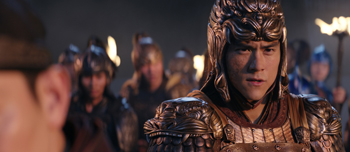 'The first day that I met him, I realised that what he does is a martial art," Matt Damon states. 'He taught me so much more than just the skill of archery; spending time with him, you note the steadiness that is in him. The way that he is in the world was helpful while I was figuring out how to play this character."
'The first day that I met him, I realised that what he does is a martial art," Matt Damon states. 'He taught me so much more than just the skill of archery; spending time with him, you note the steadiness that is in him. The way that he is in the world was helpful while I was figuring out how to play this character."
Blending Eras and Cultures: Costume Design
Dunckley's cache of weapons, although part of the film's prop department, were the last items applied as each of the cast got into character on set every day. They are an extension of the characters' wardrobes, meaning Dunckley worked hand-in-hand with the production's veteran costume designer, Mayes Rubeo, whose award-winning resume includes such big screen epics as Avatar, Apocalypto and Warcraft.
Matt Damon commends: 'Her designs for an entire army"hundreds upon hundreds of extras, all in full battle gear"wow! It was cool to walk on the set and see that. It felt like what it must have been like to make a movie in 1945. There was nothing accidental about any single color in the film's wardrobe. Knowing Yimou's use of color, every single uniform color has a purpose.
Rubeo agrees that the colors not only were important for story, but they were crucial to a filmmaker who is a master of color. 'We had conversations that included the philosophy of colors," she states. 'It wasn't as simple as blue, red, yellow. There were many meetings about the right hue of color."
Zhang has worked with some of China's finest costume designers during his three-decade career. His 2006 drama, Curse of the Golden Flower, even picked up an Oscar® nomination for Chung Man Yee's lavish wardrobe. Rubeo explains her role: 'The reason why director Zhang chose me was because he wanted to do something different," she offers. 'He wanted me to bring something more to the table, to give the film a new twist. The greatest satisfaction for me was having the trust of a maestro like Zhang Yimou."
'The movie is set during the Song Dynasty of the 12th century, and many of the designs were based on the historical costumes," she says. 'Being a fantasy movie, we had the opportunity to move it into a more eclectic or whimsical direction. The fantasy element to the story was great for me because I was not an expert on period costumes from China of the 12th century. So, I had some creative license. I utilized Chinese fabrics, Chinese textiles, and Chinese techniques. I also brought many fabrics from the Western world, from Europe, France and Italy. This is where you see the crossover in the costumes with those Chinese prints, which added more depth."
Working with a staff of six dozen craftspeople, Rubeo says the biggest challenge for her was designing The Nameless Order outfits. 'Each one had a specific task in the strategic military functions of defending The Wall, and the whole future of China. It was challenging to make those costumes because each one had to be very specific, as each corps had a different rank."
For every costume Rubeo's team manufactured for The Nameless Order soldiers, each set of armor had about 18 elements to it, including typical pieces such as the helmet, the pauldron (a piece of plate armor for the shoulder and the uppermost part of the arm), the vambrace (plate armor for the forearm), grieves (armored shin pieces), tassets (armor for the upper legs) and boots.
She and her team fabricated everything at China's Barong factory, a place familiar with Zhang Yimou's past work, having made costumes for many of his earlier projects. Rubeo affirms that one can only do these kinds of films with the great skill she found in China's craftspeople. That talented team virtually took over the factory, given that she spent months making 863 hero and stunt double costumes for the film's 40 key-speaking roles. In total, more than 10,000 costume pieces (13,140 to be exact!) for the key cast and the 500 extras who played warriors in the five regiments of The Nameless Order.
For the film's five main characters, Rubeo details the respective designs for each, beginning with William Garin. 'The first time we see William, he is coming through the Silk Road and encounters a couple of very dangerous situations," she begins. 'So, we wanted a very dirty look. He was in disguise with a caped tunic that we put on him. However, Lin Mae soon learns he and Tovar weren't actually merchants when she discovers he is wearing leather armor. This is defense armor and was made in a way that was almost like a parcel of pieces of leather that move with the shape of the person."
'So, the idea of William's costume is a result of somebody putting together makeshift armor," she points out. 'He is a ruthless thief. What you see in his costume early on are pieces of chain mail, pieces of armor, and metal scales. You can't figure out what kind of outfit it is except that he probably was looting here and there to create his own armor."
Moving on to Ballard's look, Rubeo says she talked with Dafoe regarding the idea behind Ballard's costume. 'There were two opinions about it in our discussion with Zhang Yimou," she remembers. 'At the beginning, the director wanted Willem to be almost whimsical with a touch of comic relief. Willem said he didn't see himself like that. He saw Ballard as a fastidious expert. He arrived at the walled city and had to stay because it was convenient. So, he stayed and his costume became a fusion of Asian and a medieval Western look."
'Strategist Wang wears a typical costume given he is a writer and a poet as well as an astronomer and a scientist," Rubeo continues. 'Also, he is the one that makes all the proposals for military defense and analysis. Because it's more like being an engineer and a thinker, Secretary of State, his costume could not be military because of his assorted responsibilities. We did take some license again by giving him chest armor. The chest armor is the equivalent of wearing Kevlar of the times. Constantly training to wait for the beast."
Rubeo admits that the costume design for Lin Mae and the Crane Corps 'was the most difficult because it was so important to get it right. They are the airborne corps. They jump from a platform and their costume is blue because when the Tao Tei looks at them, the color acts as a camouflage against the sky. We probably did 50 sketches for these characters before we got it right."
Amid dozens of character designs and thousands of individual pieces to dress both the key cast and the several hundred extras, the veteran designer is most proud of her work on the story's Emperor, for whom she made a single costume with no duplicates.
'In Imperial China, the only one that could wear a dragon was the Emperor," she explains. 'The dragon on the Emperor has to have five fingers.
For the costume itself, the director wanted this very young Emperor to look like a walking jewel"giving the air that he has been so overprotected by his retinue. The embroidery that we used was basic, to which we added metallic coils and semiprecious stones. It's a costume that looks good from afar, but, up close, you see that it's a work of art. It was a labor of love for us."
In discussing each regiment of The Nameless Order, Rubeo states: 'Each commander has a certain mission and look in The Nameless Order. Starting with Commander Shao, who wears a black costume, we utilized different techniques of traditional costumes from the warriors of that era. From metal scales to a mountain pattern, which is characteristic of chain mail from China of those times. We dressed the Bear Corps in black because we wanted the costume to reflect the animal itself."
'For the Eagles, we wanted them in red because this is a color that our director loves and it was the regiment that we were perhaps going to see on the screen the most," she states. 'So, we considered what colors would combine best and which the audience would react to best. We made the Deer purple. This is the cavalry of The Nameless Order. For the Deer commander, we created horns on his helmet. The intention was to create a menacing look so the enemy would be scared off."
Her design for the Tiger commander was also meant to intimidate, with Rubeo sharing: 'His helmet is gold and the head of a tiger with an open mouth. Through the mouth, you see the face of the commander. This is a helmet design that you often see in many armored civilizations of the world. You can find it from Caballeros, from the Aztec civilization to Hercules or Alexander the Great's army. They also used the heads of lions as a helmet motif."
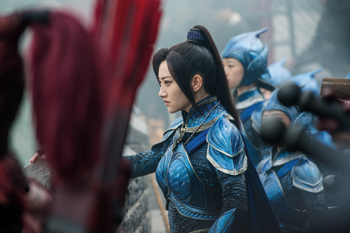 An Unthinkable Threat: Tao Tei Are Born
An Unthinkable Threat: Tao Tei Are Born
While Rubeo was instrumental in bringing the film's human characters to life through her glorious fabric designs, Oscar®-nominated VFX supervisor Phil Brennan fabricated the movie's beastly antagonist, the mythological Tao Tei. Brennan, speaking from the set a few weeks after production commenced, offered an early view of what to expect from his creation. He was months away from giving digital birth to the Tao Tei species, following the lengthy shoot in China which concluded in early August, 2015.
'The Tao Tei was not just a creation for the film, but is actually part of Chinese mythology," Brennan relays. 'The dragon had nine sons, and one of them was the Taotie. This creature was known for having a voracious appetite, and it is scattered throughout Chinese culture. It's never been realized in this form before in a film."
'They're large, about the size of a grizzly bear," the VFX supervisor notes. 'They have huge mouths, and can rip people to shreds in seconds. They like to eat people because they're all about consuming and representing greed. That huge appetite has helped shape the creatures with their large mouths. They can detach their jaw in the same way a snake can."
There are three different types of Tao Tei in our story. The Drone is the Tao Tei foot soldier"the first wave of 'scouts," a mindless attack force following the Queen's orders. As Brennan describes them, 'they are Grizzly-sized and muscular, with a large head, blood-red mouth, jagged teeth with a razor-sharp claw, all covered in jade skin, its color relating to the film's jade motif. There are tens of thousands of them and the one that we see the most."
The Paladins are the Queen's imperial guards: twice as large, armored plating, highly disciplined, defending their leader at all costs. Brennan calls this breed 'the personal guard of the Queen, or the Alpha. So, there's much fewer of those, but they're much bigger creatures whose sole job is to protect the Queen." The Queen is the mastermind controlling the Tao Tei army. Without her, they become mindless cannibals. Huge, dark translucent skin, rows of blood stained teeth, intelligent green eyes are her key traits. 'She controls the other creatures," Brennan says. 'But, her main purpose is to breed, and that's what our army tries to stop from happening. The Drones go out, consume people and come back and regurgitate the food to her; she feeds off their conquests."
While filming ensued, Brennan and his team continued studies regarding the physicality and motion of the mythical creature. 'For speed, we looked into cheetahs, tigers and leopards," he concludes. 'We studied a lot of other creatures as well, for instance, the gorilla, hose and bull. So, we've combined a lot of different things, and then on top of that we'll give it a unique motion of its own that doesn't come from any particular existing creature."
Seaside to the Desert: Additional Locations
Beyond his designs for the Tao Tei creatures, Brennan's VFX team (he secured the talents of Industrial Light & Magic) was also responsible for many other VFX to fill in-camera frames captured on set and location. 'On a movie like this, there obviously are a lot of visual effects," he states. 'Probably three main areas. The first are the tens of thousands of Tao Tei. The second thing is the army. We did have a lot of extras, but at the same time, this is an army that's comprised of tens of thousands of soldiers. So, we had to create a digital army and extend what we've shot to show the staggering scale of it."
'Finally, the third important thing we have to do involves The Great Wall itself," he concludes. 'On this backlot, we had pieces of The Great Wall, and we had small pieces of the Forbidden City. But, the majority of what you see in the background is a CG creation. So, we had to build the whole environment around the outdoor scenes."
The film's outdoor scenes were staged in three different locations"Huangdao, a seaside community on the shores of the Yellow Sea, where Myhre's Great Wall set pieces were erected in a site measuring one square kilometer. The other two locations were situated 1,200 miles from Beijing in the Gobi Desert in China's vast Gansu Province. Gansu is a location in which Zhang Yimou had worked on both Hero and A Woman, A Gun and A Noodle Shop.
'Gansu Province is the gateway to China through the Silk Road," Loehr shares. 'It is also the home of other natural formations like the Painted Mountains and the Yadan Geopark, which, geographically, suited the opening and closing moments of the story."
In returning to the remote and foreboding Yadan National Geopark about three hours by car from Dunhuang (yes, the crew had a daily six-hour roundtrip drive to-and-from this distant locale during the course of a seven-day shoot), Zhang went back to a breathtaking vista that could compare to John Ford's distinguishing use of Monument Valley on the Arizona-Utah border.
Yadan Geopark features a land mass called Yardang, a geological feature created by the soft part of the earth's surface being eroded by wind and rain, with the hard part of the rocks remaining in the desert. These geomorphic formations, which developed over a period of 700,000 years, are the largest in China.
Shooting on Location: Danxia Geological Park
In A Woman, a Gun and a Noodle Shop (his 2009 take on Coen Bros.' debut feature, Blood Simple), Zhang Yimou became the very first filmmaker to shoot a movie in one of the planet's most eye-catching environments: the Painted Mountains of Danxia's Geological Park. The geomorphology offers a unique backdrop for any feature, and Zhang states that it became a famous tourist spot after the 2009 film came out. This time, he wanted to film actors Matt Damon and Pascal coming over the Silk Road to The Great Wall in this location.
Danxia Geological Park covers an area of 510 square kilometers (200 sq. mi). Located in the northern foothills of the Qilian Mountains, Zhangye Danxia is known for the unusual colors of the rocks, which are smooth, sharp and several hundred meters tall. They are the result of deposits of sandstone and other minerals that occurred over 24 million years. It has been voted by Chinese media as one of the most beautiful landforms in China.
'We didn't originally choose this place for the film," Zhang states. 'We chose many places to play the Silk Road, and all would have worked. Later, I said there is another place where I have filmed before. As soon as they saw pictures of Danxia, everybody didn't believe it was real. They thought the landscape was dyed."
'Later I thought, because I had already filmed there, I would be repeating myself," he admits. 'But I felt I was not repeating myself with places I'd discovered because the whole world has not seen Danxia yet. I knew we could make it even more beautiful with new special effects."
Production wrapped, the cast and crew take a moment to reflect on this colossal achievement. In reflecting on his experiences, Matt Damon states: 'Zhang Yimou's understanding of spectacle is insane. It's a classic Saturday-night popcorn movie, but one that plays to all cultures. That was the goal, for us to come together in this international group in China and make a fantastical battle picture, with the fate of the human race hanging in the balance. We were all excited to be there in China. And, everyone was there because of Zhang Yimou. We all felt lucky to be part of one of his visions."
Tull, whose years-ago idea for a monster movie set on China's Great Wall came to fruition and brought together two diverse cultures, concludes: 'The Great Wall is something so iconic to China. Now, we have a great big, intelligent and fun monster movie set on The Wall. With the scope of everything that Zhang Yimou brought to the table, the colors, the scale, the weapons, the monsters it has so much eye candy. I can't wait until people get to see the movie."
Zhang Yimou feels that The Great Wall has become an epic fantasy event that evokes the inspiration he felt when visiting China's signature landmark as a teenager in 1967. He ends: 'The first time I saw The Great Wall was during China's Cultural Revolution when I was 17. I found it to be truly unbelievable. In making this film, our balance was to integrate these Chinese elements and story concepts into a blockbuster. Now, our film is the very first one made about The Wall in China with such a huge budget and grand scale."
The Great Wall
Release Date: February 16th, 2017
Have You Seen This?
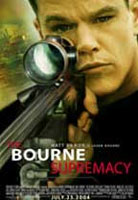
Matt Damon - The Bourne Supremacy
Matt Damon is back for round two as Jason Bourne, Damon seemed to fit the character like a glove.
MORE


